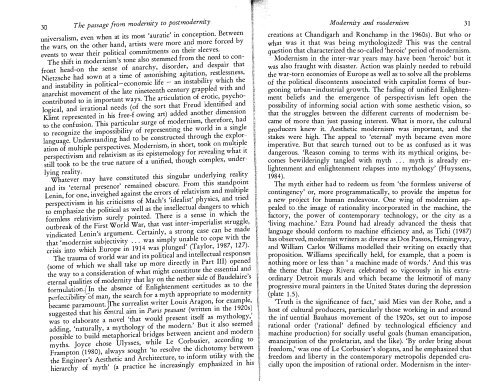The Condition of Postmodernity 13 - autonomous learning
The Condition of Postmodernity 13 - autonomous learning
The Condition of Postmodernity 13 - autonomous learning
Create successful ePaper yourself
Turn your PDF publications into a flip-book with our unique Google optimized e-Paper software.
30 <strong>The</strong> passage from modernity to post modernityuniversalism, even when at its most 'auratic' in conception. Betweenthe wars, on the other hand, artists . were more an more forced byevents to wear their political commItments on theIr sleeves.<strong>The</strong> shift in modernism's tone also stemmed from the need o confronthead-on the sense <strong>of</strong> anarchy, . diorder ? a ? -d despaIr thatIetzsc e a. . .h· h hN· h h d sown at a time <strong>of</strong> astolllshmg agItatlon, restlessness,and instability in political-economic life - an mstabIhty w c t eanarchist movement <strong>of</strong> the late nineteenth . centl ry grapple wIth andcontributed to in important ways. <strong>The</strong> artIculatlon <strong>of</strong> e!"ouc, . psychological,and irrational needs (<strong>of</strong> te sort that F reud Identfied ndKlimt represented in his free-flowmg art) added nother dImenSIOnto the confusion. This particular surge <strong>of</strong> oderlllsm, theefore, .hadto recognize the impossibility <strong>of</strong> representmg the world m a smglelanguage. Understanding had to be co ? -strcted through the exporation<strong>of</strong> multiple perspectives. oAerllsm, m short, took n mulupl .eperspectivism and relativism as ItS epIsemology for reveaJmg what Itstill took to be the true nature <strong>of</strong> a umfied, though complex, underlyingreality.. . . rWhatever may have constituted thIS smgular undelymg rea tyand its 'eternal presence' remained obscure. Fro. thIS standp mtLenin, for one, inveighed against the errors . <strong>of</strong> rlatlvism . and mulupleperspectivism in his criticisms <strong>of</strong> Mach' 'IdealIst' phYSICS, and tredto emphasize the political as w:ell as the mtelectual dan?ers to . whIchformless relativism surely pomted. <strong>The</strong>re IS a ense . m . whIch theoutbreak <strong>of</strong> the First World War, that vast inter-lmpenalIst struggle,vindicated Lenin's argument. Certainly, a strong case can be . madethat 'modernist subjectivity ... was simply unable to cope WIth thecrisis into which Europe in 1914 was plunged' .(Taylor, 1987, 127).<strong>The</strong> trauma <strong>of</strong> world war and its polItical and mtellectual responses(some <strong>of</strong> which we shall take up mre directlf in Part III) penethe way to a consideration <strong>of</strong> what mIght constltut the essentlal . aneternal qualities <strong>of</strong> modernity that lay on the nether sIe <strong>of</strong> BaudelaIre sformulation.!' In the absence <strong>of</strong> Enlightenment cerItudes as to t?eperfectibility l <strong>of</strong> man., the search for a . myth apropnate to modernItybecame paramount. rrhe surrealist wnter LOUIS Argon, . for example,suggested that his central aim in Paris peasant (wntten m the 1920swas to elaborate a novel 'that would present itself as mythology,'adding, 'naturally, a mythology <strong>of</strong> the modern.' Bt it also seemedpossible to build metaphorical bridges between anIent and n : odernmyths. Joyce chose Ulysses, while Le CorbuIer, accordmg toFrampton (1980), always sought ':0 resolve te dichoty btweenthe Engineer'S Aesthetic and ArchIteture, tọ mform utllI y wIh tehierarchy <strong>of</strong> myth' (a practice he mcreasmgly emphaSIzed m hISModernity and modernism 31creations at Chandigarh and Ronchamp in the 1960s). But who orwhat was it that was being mythologized? This was the centralquestion that characterized the so-called 'heroic' period <strong>of</strong> modernism.Modernism in the inter-war years may have been 'heroic' but itwas also fraught with disaster. Action was plainly needed to rebuildthe war-to: econ . omies <strong>of</strong> Europe as well as to solve all the problems<strong>of</strong> the polItical dIscontents associated with capitalist forms <strong>of</strong> burgeoningurban-industrial growth. <strong>The</strong> fading <strong>of</strong> unified Enlightenmentbeliefs and the emergence <strong>of</strong> perspectivism left open thepossibility <strong>of</strong> informing social action with some aesthetic vision, sothat the struggles between the different currents <strong>of</strong> modernism became<strong>of</strong> more than just passing interest. What is more, the culturalproducers knew it. Aesthetic modernism was important, and thestakes were high. <strong>The</strong> appeal to 'eternal' myth became even moreimperative. But that search turned out to be as confused as it wasdangerous. 'Reason coming to terms with its mythical origins, becomesbewilderingly tangled with myth ... myth is already enlightenmentand enlightenment relapses into mythology' (Huyssens,1984 ).<strong>The</strong> myth either had to redeem us from 'the formless universe <strong>of</strong>contingency' or, more programmatically, to provide the impetus fora new project for human endeavour. One wing <strong>of</strong> modernism appealedto. the image <strong>of</strong> rationality incorporated in the machine, thefactory, the power <strong>of</strong> contemporary technology, or the city as a'living machine.' Ezra Pound had already advanced the thesis thatlanguage should conform to machine efficiency and, as Tichi (1987)has observed, modernist writers as diverse as Dos Passos, Hemingway,and William Carlos Williams modelled their writing on exactly thatproposition. Williams specifically held, for example, that a poem isnothing more or less than ' a machine made <strong>of</strong> words.' And this wasthe theme that Diego Rivera celebrated so vigorously in his extraordinaryDetroit murals and which became the leitmotif <strong>of</strong> manyprogressive mural painters in the United States during the depression(plate 1.5).'Truth is the significance <strong>of</strong> fact,' said Mies van der Rohe, and ahost <strong>of</strong> cultural producers, particularly those working in and aroundthe influential Bauhaus movement <strong>of</strong> the 1920s, set out to imposerational order ('rational' defined by technological efficiency andmachine production) for socially useful goals (human emancipation,emancipation <strong>of</strong> the proletariat, and the like). 'By order bring aboutfreedom,' was one <strong>of</strong> Le Corbusier's slogans, and he emphasized thatfreedom and liberty in the contemporary metropolis depended cruciallyupon the imposition <strong>of</strong> rational order. Modernism in the inter-
















